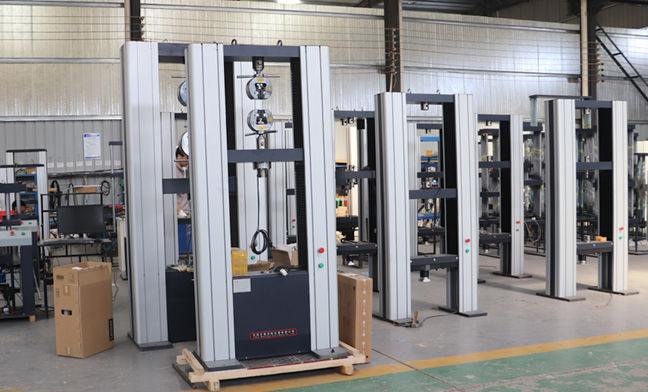Introduction
Universal Testing Machines (UTMs) are a cornerstone of modern materials testing. Among the many tests UTMs can perform, compressive strength testing is one of the most widely used and essential across industries such as construction, manufacturing, aerospace, and automotive. This article will dive deep into how UTMs measure compressive strength, why it matters, and how to interpret the results effectively. Whether you’re a quality engineer, materials scientist, or a manufacturer, understanding compressive strength testing is crucial for ensuring the integrity and safety of your products.
What Is Compressive Strength?
Compressive strength refers to the maximum compressive load a material can withstand before failure. It is measured in force per unit area, typically in megapascals (MPa) or pounds per square inch (psi). Unlike tensile strength, which deals with how much a material can stretch before breaking, compressive strength focuses on how much pressure it can resist before being crushed or deformed.
Why Compressive Strength Matters
Structural Safety: In civil engineering, compressive strength is a critical factor in the design of concrete, bricks, and other building materials.
Material Selection: Engineers use compressive strength data to choose the right materials for load-bearing applications.
Quality Control: Manufacturers routinely test compressive strength to meet industry standards and ensure product reliability.
What Is a Universal Testing Machine (UTM)?
A Universal Testing Machine is a versatile piece of equipment used to test the mechanical properties of materials under various loads, including tension, compression, bending, and shear. UTMs come in two primary types:
Electromechanical UTMs: Ideal for low- to medium-force applications.
Hydraulic UTMs: Preferred for high-force testing, especially in compressive tests of concrete, metals, and ceramics.
Core Components of a UTM
Load frame: The main structure that supports the specimen during testing.
Actuator or crosshead: Moves up or down to apply the load.
Load cell: Measures the force applied to the specimen.
Extensometer or displacement transducer: Measures strain or deformation.
Control system: Often PC-based, used to operate the machine and record data.
How a UTM Measures Compressive Strength
Step-by-Step Process
Sample Preparation
Specimens must be prepared according to standards (e.g., ASTM C39 for concrete or ASTM E9 for metals). The surface must be flat, parallel, and clean.Machine Setup
Choose the appropriate compression platens.
Calibrate the load cell.
Input test parameters into the control software.
Load Application
The UTM applies a compressive load at a constant rate. The force and deformation are continuously recorded.Failure Detection
The test continues until the specimen fractures, deforms excessively, or reaches a preset limit.Data Output
The machine software provides a stress-strain curve, maximum load, deformation, and compressive strength.
Common Materials Tested for Compressive Strength
| Material | Typical Compressive Strength | Standards Used |
|---|---|---|
| Concrete | 20–40 MPa | ASTM C39, ISO 4012 |
| Metals (Steel) | 250–500 MPa | ASTM E9, ISO 604 |
| Ceramics | >1000 MPa | ASTM C1424 |
| Polymers | 20–100 MPa | ASTM D695, ISO 604 |
| Composites | 50–400 MPa | ASTM D6641 |
Standards and Compliance
ASTM and ISO Standards
To ensure accuracy and repeatability, compressive strength tests using UTMs are governed by international standards:
ASTM C39: Standard for testing cylindrical concrete specimens.
ASTM D695: Standard for testing the compressive properties of plastics.
ASTM E9: Test method for compressive testing of metallic materials at room temperature.
ISO 604: Determines compressive properties of plastics.
EN 12390: Commonly used in Europe for concrete compression tests.
Following these standards ensures the data is valid for regulatory, research, and quality assurance purposes.
Applications of Compressive Strength Testing
1. Construction Industry
Ensures that concrete used in buildings and bridges can bear expected loads.
Verifies the compressive integrity of bricks, blocks, and structural panels.
2. Automotive and Aerospace
Tests metal components like shafts, gears, and bolts for resistance under crash or pressure conditions.
3. Manufacturing and Quality Control
Verifies product performance during mass production.
Detects defects in materials such as plastic molds, foam padding, and packaging materials.
4. Research and Development
Used in material design to innovate new composites with higher strength-to-weight ratios.
Tips for Accurate Compressive Strength Testing
Calibrate Regularly
Always calibrate the UTM with certified equipment to ensure accurate readings.Use Proper Fixtures
Misalignment can lead to incorrect data. Use spherical seated compression platens if needed.Condition the Samples
Ensure samples are tested in consistent conditions (humidity, temperature, moisture content).Avoid Stress Concentration
Edges and corners should be smooth; avoid notches or uneven surfaces.Software Validation
Ensure the test software is updated and compatible with standards.
Compressive Strength vs. Other Mechanical Properties
| Property | Description | Test Type |
|---|---|---|
| Compressive Strength | Resistance to crushing loads | Compression Test |
| Tensile Strength | Resistance to pulling/stretching loads | Tension Test |
| Flexural Strength | Resistance to bending | Bending Test |
| Shear Strength | Resistance to sliding layers | Shear Test |
| Modulus of Elasticity | Ratio of stress to strain in elastic range | All types of tests |
Understanding how compressive strength compares to other properties helps in selecting the right material for a specific application.
Advantages of Using UTMs for Compression Testing
Versatility: Test multiple materials with the same machine.
High Precision: Advanced load cells and sensors ensure accurate results.
Digital Recording: Real-time data collection and stress-strain curve generation.
Compliance: Meets global testing standards for legal and regulatory requirements.
Automation: Reduces human error and speeds up testing processes.
Conclusion
Universal Testing Machines play a vital role in determining the compressive strength of materials, a property crucial for structural integrity and product performance. From concrete to composites, understanding how materials respond to compressive forces helps engineers and manufacturers ensure safety, compliance, and reliability. By adhering to testing standards and using calibrated, high-quality UTMs, you can gather dependable data that drives better decisions in research, development, and production.
FAQs
Q1: What is the ideal UTM for concrete compressive testing?
A hydraulic UTM with a minimum capacity of 2000 kN is ideal for testing large concrete specimens as per ASTM C39.
Q2: Can I test small plastic parts with the same machine?
Yes, with interchangeable fixtures and load cells, UTMs can switch between high and low-force applications.
Q3: How often should I calibrate my UTM?
It is recommended to calibrate your UTM at least once per year or after 1000 test cycles.
Q4: What if my sample fails early?
Check for improper alignment, poor surface finish, or internal defects in the specimen.









